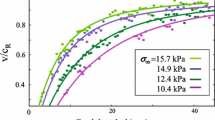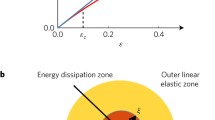Abstract
Problems of characterizing the stress wave induced stress field around the crack tip and ensuing crack propagation behavior are described. After stating the assumptions underlying an idealized model of brittle, dynamic fracture we review experimentally observed deviations from such idealized behavior. Such deviations are ascribed to the development of numerous microcracks in the crack tip region. These microcracks determine the crack initiation process, the speed of crack growth and the branching phenomenon. Also we examine critically the contention that there exists a unique relation which links instantaneous crack speed to the instantaneous stress intensity factor in brittle solids. That question highes materially on limitations of current measurement techniques.
Résumé
On décrit les problèmes de caractérisation du champ de contrainte induit autour de l'extrémité de l'entaille par une onde de tension et les conséquences qui en résultent sur le comportement à la propagation d'une fissure. Après avoir posé les hypothèses soujacentes à un modèle idéal de rupture fragile et dynamique, on passe en revue les déviations observées par voie expérimentale à partir d'un tel modèle. Ces déviations sont attribuées au développement de nombreuses microfissures dans la région de l'extrémité de la fissure. Ces microfissures déterminent un processus d'amorçage de fissure, une vitesse de croissance de la fissure et un phénomène d'arborescence. On examine également de manière critique l'assertion selon laquelle il existe une relation unique qui relie la vitesse instantaneée de la fissure au facteur d'intensité d'entaille instantané dans des solides fragiles. La solution à cette question est matériellement gènée par des limitations dans les techniques de mesure habituelles.
Similar content being viewed by others
References
J. Hopkinson, Original Papers, Cambridge University Press (1901) 316–320.
B. Hopkinson, Scientific Papers (1912) 461.
K.B. Broberg, Journal of Applied Mechanics 22 (1955) 317–323.
H. Kolsky and D.G. Christie, Transactions, Society of Glass Technology 36T (1952) 88.
D.R. Curran, D.A. Shockey, and L. Seaman, Journal of Applied Physics 44 (1973) 4025.
S.N. Zhurkov and V.S. Kuksenko, International Journal of Fracture 11 (1975) 629–639.
D.A. Shockey, L. Seaman and D.R. Curran, International Journal of Fracture 27 (1985) 145–157.
J.D. Achenbach, in Mechanics Today 3. Edited by Nemat-Nasser, Pergamon Press (1974) 1.
L.B. Freund, in Mechanics Today 3. Edited by Nemat-Nasser, (1976) 55–90.
C. Atkinson and J. Eshelby, International Journal of Fracture 4 (1968) 3–8.
L.B. Freund, Journal of Elasticity 2 (1972) 341.
K. Ravi-Chandar and W.G. Knauss, International Journal of Fracture I: 25 (1984) 247–262; II: 26 (1984) 65–80; III: 141–154; IV: 193–204.
L.R.F. Rose, International Journal of Fracture 12 (1976) 799–813.
J.D. Eshelby, in Inelastic Behavior of Solids. Edited by Kanninen et al McGraw-Hill, New York (1970) 111.
A.A. Wells and D. Post, Proceedings, SESA 16 (1958) 69.
W.M. Beebe, Ph.D. Thesis, California Institute of Technology (1966).
J.F. Kalthoff, International Journal of Fracture 27 (1985) 277–297.
M.L. Kanninen, International Journal of Fracture 27 (1985) 299–312.
E. Yoffe, Philosophical Magazine 42 (1951) 739.
A.W. Maue, Zeitschrift fur Angewandte Mathematik und Mechanik 34 (1954) 1.
D.D. Ang, Ph.D. Thesis, California Institute of Technology (1958).
A.T. De Hoop, Doctoral Dissertation, Technische Hogeschool, Delft (1958).
K.B. Broberg, Arkiv. fur Physik 18 (1960) 159.
J.W. Craggs, Journal of Mechanics and Physics of Solids 8 (1960) 66.
B.R. Baker, Journal of Applied Mechanics 29 (1962) 449.
P.B. Crosley and E.J. Ripling, Journal of Basic Engineering 91 (1969) 525–534.
L.B. Freund, Journal of Mechanics and Physics of Solids 21 (1973) 47.
K. Ravi-Chandar and W.G. Knauss, International Journal of Fracture 20 (1982) 209–222.
C.C. Ma and L.B. Freund, Brown University Report (September 1984).
K. Ravi-Chandar, and W.G. Knauss, SM Report 84–18, California Institute of Technology (1984).
J.W. Dally, W.L. Fourney and G.R. Irwin, International Journal of Fracture 27 (1985) 159–168.
A.J. Rosakis and K. Ravi-Chandar, Galcit SM Report 84–2, California Institute of Technology (March 1984).
J.G. Williams and J.M. Hodgkinson, Proceedings, Royal Society of London A 375 (1981) 231–248.
W.G. Knauss, inProceedings, Sixth International Conference on Fracture, S.R. Valluri et al. (editors) New Delhi, India, December 1984, Pergamon Press.
D.A. Schockey, J.F. Kalthoff, H. Homma and D.C. Erlich in Proceedings, Workshop on Dynamic Fracture, California Institute of Technology, Pasadena, CA (Feb. 1983) 57–71.
H. Schardin, in Fracture. Edited by Averbach et al., Technology Press MIT, John Wiley & Sons and Chapman & Hall (1959).
W.B. Bradley and A.S. Kobayashi, Engineering Fracture Mechanics 3 (1971) 317.
J.F. Kalthoff, in Proceedings, Workshop on Dynamic Fracture, California Institute of Technology (1983) 11–35.
T. Kobayashi and J.T. Metcalf, in Crack Arrest Methodology and Application, ASTM STP 711 (1980) 128.
J.W. Dally and A. Shukla, Mechanics Research Communication 6 (1979) 239.
J.E. Field, Contemporary Physics 12 (1972) 1.
J. Congleton et al., Philosophical Magazine 16 (1967) 749.
J. . Pucik, Ph.D. Thesis, California Institute of Technology (1972).
J. Carlsson, in Transactions of the Royal Institute of Technology, Stockholm; (a) Vol. 189 (1962) 2–55; (b) Vol. 205 (1963) 3–38; (c) Vol. 207 (1963) 3–26.
J.W. Dally, Experimental Mechanics 19 (1979) 349.
J.P. Dempsey and P. Burgers, International Journal of Fracture 27 (1985) 203–213.
M. Ramulu and A.S. Kobayashi, International Journal of Fracture 27 (1985) 187–201.
B. Cotterell and J.R. Rice, International Journal of Fracture 16 (1980) 155–169.
Author information
Authors and Affiliations
Rights and permissions
About this article
Cite this article
Knauss, W.G., Ravi-Chandar, K. Some basic problems in stress wave dominated fracture. Int J Fract 27, 127–143 (1985). https://doi.org/10.1007/BF00017963
Received:
Issue Date:
DOI: https://doi.org/10.1007/BF00017963




